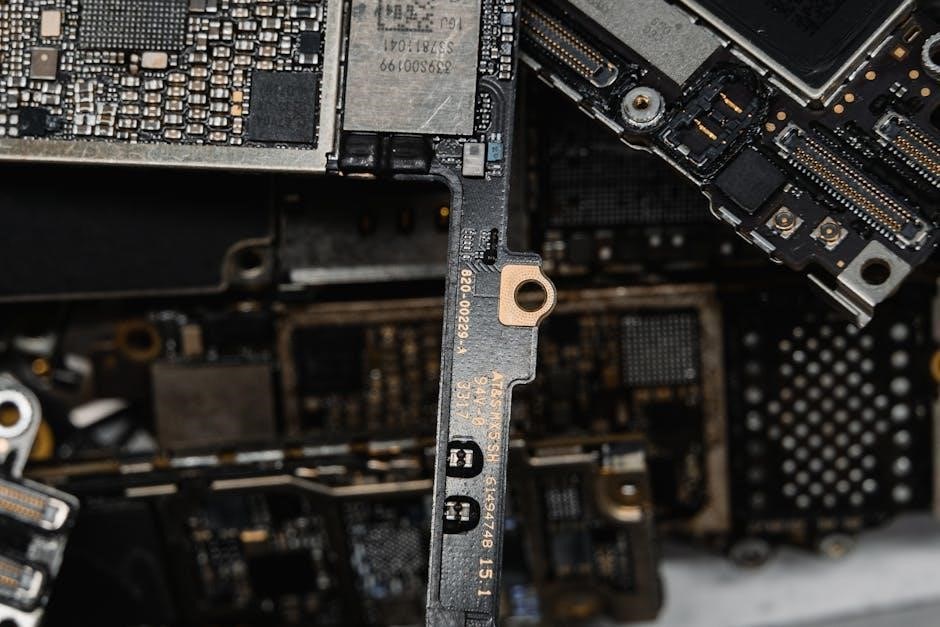Data center infrastructure design is critical for supporting mission-critical systems, ensuring scalability, reliability, and efficiency. It involves housing servers, storage, and networking equipment securely.
Overview of Data Center Importance
Data centers are the backbone of modern IT infrastructure, housing critical systems, applications, and data essential for business operations. They enable efficient data storage, processing, and distribution, supporting digital transformation across industries. By providing secure, scalable, and reliable environments, data centers ensure uninterrupted service delivery, safeguarding organizational assets and maintaining competitive advantage. Their importance extends to supporting cloud computing, AI, and IoT, making them indispensable for future technological advancements and global connectivity. Properly designed data centers are vital for meeting growing demands, ensuring redundancy, and optimizing resource utilization, ultimately driving business growth and innovation.
Key Objectives of Data Center Design
The primary objectives of data center design focus on ensuring high availability, scalability, and energy efficiency while maintaining security and cost-effectiveness. Designers aim to create flexible infrastructures that adapt to evolving technological demands, such as increased cloud computing and AI workloads. Redundancy is a critical factor to prevent single points of failure, ensuring continuous operations. Additionally, optimizing power and cooling systems to minimize environmental impact and operational costs is essential. Security measures, including both physical and digital safeguards, are integrated to protect sensitive data. These objectives collectively ensure that data centers meet current requirements while being future-ready to support innovation and growth.

Data Center Architecture Overview
Data center architecture provides a structured framework for integrating compute, storage, and networking resources, ensuring scalability, redundancy, and efficiency to support critical business operations effectively.
Data Center Design Models
Data center design models provide frameworks for organizing infrastructure to meet specific business needs. The multi-tier model offers scalability and redundancy, separating components into tiers based on functionality. Tier I focuses on basic infrastructure, while Tier IV provides full redundancy. The server cluster model groups servers for high availability and resource sharing, enhancing efficiency. Both models aim to ensure reliable, scalable, and efficient operations, supporting enterprise applications and adapting to organizational growth. These designs emphasize redundancy, failover mechanisms, and standardized infrastructure to minimize downtime and optimize performance. By aligning with these models, organizations can create robust data centers tailored to their operational demands and future scalability needs.

Multi-Tier and Server Cluster Models
Multi-tier and server cluster models are essential frameworks for data center infrastructure design. The multi-tier model organizes infrastructure into distinct layers, such as access, distribution, and core, each handling specific functions. This structure enhances scalability, security, and manageability. Server cluster models group servers to ensure high availability and resource sharing, improving efficiency and fault tolerance. These models are widely adopted due to their flexibility and ability to adapt to evolving business needs. By implementing these designs, organizations can achieve robust, scalable, and highly available data centers, ensuring optimal performance and minimal downtime. These approaches are integral to modern data center design, supporting the demands of enterprise applications and future growth.
Infrastructure Components
Data center infrastructure includes electrical power systems, cooling systems, and network infrastructure, ensuring efficient, reliable, and scalable operations. These components are critical for maintaining performance and uptime.
Electrical Power Systems
Electrical power systems are a cornerstone of data center infrastructure, ensuring uninterrupted power supply to all critical components. These systems must be highly reliable, efficient, and scalable to support growing demands. Key components include UPS (Uninterruptible Power Supplies), PDU (Power Distribution Units), and backup generators. Redundancy is essential, with many data centers adhering to Tier III or IV standards, which require no single point of failure. Proper power distribution ensures that servers, cooling systems, and network devices operate seamlessly. Designing these systems involves calculating load requirements, implementing energy-efficient technologies, and future-proofing for expansion. A well-planned electrical infrastructure minimizes downtime, reduces operational costs, and supports long-term business continuity. Regular maintenance and monitoring are crucial to uphold performance and reliability.

Cooling Systems and Thermal Management
Cooling systems are vital for maintaining optimal temperatures in data centers, ensuring hardware reliability and performance. Modern designs often use air-side or water-side economization to reduce energy consumption. Components like CRAC (Computer Room Air Conditioning) units, cooling towers, and chillers are essential for heat removal. Proper airflow management, including hot-aisle and cold-aisle configurations, enhances efficiency. Liquid cooling solutions are gaining traction for high-density environments. Advanced monitoring tools optimize cooling performance, preventing overcooling and saving energy. Thermal management must align with workload demands and future scaling needs, ensuring consistent operational efficiency and minimizing environmental impact. Efficient cooling systems are critical for balancing performance, cost, and sustainability in data center operations.
Network Infrastructure Design
Network infrastructure design is foundational to data center operations, enabling efficient data transmission and connectivity. It involves designing scalable, high-performance architectures that support current and future demands. Key components include switches, routers, and cables, which must be configured to minimize latency and ensure redundancy. Multi-tier network models, such as core, distribution, and access layers, are commonly used to optimize traffic flow. Proper redundancy, through technologies like link aggregation and failover mechanisms, ensures uninterrupted service. Additionally, adherence to industry standards and the use of advanced tools, such as DCIM software, helps streamline network management and troubleshooting. A well-designed network infrastructure is essential for maintaining high availability, security, and performance in modern data centers.
Design Principles for Scalability and Redundancy
Design principles for scalability and redundancy ensure efficient resource growth and uninterrupted operations, leveraging modular designs, failover mechanisms, and load balancing to maintain high availability and performance.
Scalability in Data Center Design
Scalability in data center design ensures the infrastructure can grow efficiently to meet increasing demands without significant overhauls. Modular designs allow for incremental expansion, enabling organizations to add capacity as needed. This approach minimizes upfront costs and reduces the risk of resource underutilization. Scalable architectures also incorporate flexible power and cooling systems, which can adapt to changing workloads. By implementing multi-tier models, data centers can scale both vertically and horizontally, ensuring optimal resource utilization. Proper planning for future growth is essential, as it avoids costly retrofits and ensures the facility remains efficient over time. Scalability is a cornerstone of modern data center design, supporting long-term business growth and technological advancements.
Redundancy and Failover Mechanisms
Redundancy and failover mechanisms are vital for ensuring high availability in data centers. These systems prevent single points of failure by duplicating critical components such as power supplies, cooling systems, and network connections. Redundancy ensures that if one component fails, another can take over seamlessly. Failover mechanisms automatically switch operations to backup systems during an outage, minimizing downtime. Data centers often employ N+1 configurations, where redundant systems are always available. This approach is particularly crucial for mission-critical applications, where even brief interruptions can lead to significant losses. By incorporating redundancy and failover strategies, data centers achieve higher reliability and maintain uninterrupted service delivery, aligning with Tier III and Tier IV standards for operational excellence.

Standards Compliance in Design
Adhering to recognized standards is essential for designing efficient and reliable data centers. Key standards like EN 50600-2-1, TIA-942, and ISO/IEC 30134-1 provide guidelines for infrastructure, ensuring optimal performance and scalability. EN 50600-2-1 covers general requirements for data center design, construction, and operations. TIA-942 focuses on telecommunications infrastructure, while ISO/IEC 30134-1 addresses energy efficiency metrics. Compliance with these standards ensures that data centers meet industry benchmarks for reliability, efficiency, and sustainability. By following these guidelines, organizations can future-proof their facilities, reduce operational risks, and maintain high levels of performance. Standards compliance is a cornerstone of modern data center design, enabling businesses to achieve their operational goals effectively.

Cabling Infrastructure
Cabling infrastructure is vital for data center connectivity, ensuring high-speed data transmission and reliability. Proper planning supports scalability, future-proofing, and compliance with industry standards like TIA-942 and ISO/IEC 11801.
Telecommunications Cabling Requirements
Telecommunications cabling is a cornerstone of data center infrastructure, ensuring reliable and high-speed data transmission. Standards like TIA-942 and ISO/IEC 11801 provide guidelines for cabling systems, emphasizing scalability and future-proofing. High-performance cabling, such as Category 6A or fiber optic cables, supports 10Gbps to 40Gbps speeds. Copper cabling is suitable for shorter distances, while fiber optics excel in longer runs due to superior signal integrity. Proper cable management, including cable trays and patch panels, prevents interference and simplifies maintenance. A structured cabling system with main distribution areas (MDAs), horizontal cabling, and patching ensures flexibility. Compliance with these standards guarantees compatibility and reliability, addressing current and future demands.
Future-Proofing Cabling Systems
Future-proofing cabling systems ensures long-term scalability and adaptability to evolving technologies. High-bandwidth cables, such as OM5 fiber and Category 8, support next-gen speeds like 400Gbps. Modular cabling solutions, including MPO connectors, enable easy upgrades. Designing systems with redundancy and spare capacity allows for seamless expansion. Fiber optic cabling is preferred for its superior signal integrity and higher bandwidth potential. Regularly reviewing and updating cabling infrastructure ensures alignment with emerging standards. Proper planning prevents obsolescence, minimizing costly upgrades. A forward-thinking approach ensures the cabling system supports future demands without compromising current performance. This strategy is essential for maintaining efficiency and competitiveness in rapidly advancing data center environments.

Best Practices and Tools
Best practices include leveraging DCIM software for real-time monitoring and optimization of data center resources, ensuring efficient management and scalability. Tools like CommScope solutions enable streamlined network design, facilitating future upgrades and maintaining high performance. Proper planning and implementation of these tools are essential for achieving operational excellence and cost efficiency in modern data centers.
DCIM Software for Optimal Management
DCIM (Data Center Infrastructure Management) software is essential for optimizing data center operations. It provides real-time monitoring of power, cooling, and space utilization, enabling efficient resource management. DCIM tools integrate with HVAC, power distribution, and IT systems, offering a holistic view of infrastructure performance. By leveraging DCIM, organizations can identify inefficiencies, reduce energy consumption, and improve scalability. Advanced features include automated workload management, capacity planning, and predictive analytics, ensuring proactive decision-making. DCIM also supports compliance with industry standards and enhances security by monitoring access and environmental conditions. Implementing DCIM software is a cornerstone of modern data center design, ensuring optimal performance, cost efficiency, and future readiness.
Implementation Best Practices
Effective data center implementation requires adherence to best practices to ensure reliability and efficiency. Start with thorough planning, considering space, power, and cooling requirements. Standardized protocols for cabling, rack installation, and equipment deployment are crucial. Phased implementation allows for incremental growth, minimizing disruptions; Conduct thorough testing of all systems before full deployment. Proper documentation and training ensure smooth operations and maintenance. Scalability and redundancy should be integrated into the design to accommodate future needs. Regular maintenance and updates are essential to prevent downtime and optimize performance. By following these practices, organizations can achieve a robust, efficient, and adaptable data center infrastructure that supports long-term business goals and technological advancements.
